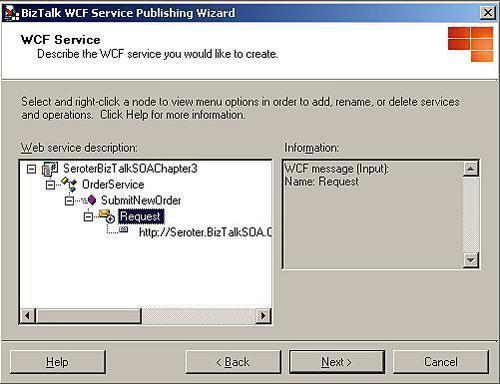We looked at accepting a new product order in an
orchestration and returning a response to the submitter. What if we
only want a one-way channel and want multiple consumers to subscribe to
this new order? This screams for a more event-driven scenario where the
publisher asynchronously sends data that is handled and acted upon by
unknown downstream systems (for example fulfilment systems, billing
systems). In this case, we aren't interested in creating an
orchestration that dictates our service contract, but rather, want to
build a service on-ramp that simply gets data onto the message bus.
For this scenario, we will:
Configure a TCP endpoint in BizTalk Server
Generate a WCF metadata service hosted in IIS that clients use to discover the service and its true service URI
Build the metadata endpoint using only schemas and no orchestrations
We will reuse the previously-built NewOrder_XML.xsd
schema as the input message to the new service. This means that this
new scenario requires no new development on our part. The scenario
begins with the creation of a new receive port and location in the BizTalkSOA application found in the BizTalk Administration Console. The receive port has the following attributes:
|
Attribute
|
Value
|
|---|
|
Port type
|
One-way
|
|
Name
|
Seroter.BizTalkSOA.Chapter3.ReceiveNewOrder
|
Next, we'll take this receive port and add a new receive location to it with the following attributes:
|
Attribute
|
Value
|
|---|
|
Name
|
Seroter.BizTalkSOA.Chapter3.ReceiveNewOrder.WcfTcp
|
|
Transport Type
|
WCF-NetTcp
|
|
Receive Pipeline
|
XMLReceive
|
|
Transport Endpoint Address
|
net.tcp://localhost:9900/
Seroter.BizTalkSOA.Chapter3.ReceiveNewOrder
|
Once
the receive location is created, it should be started to ensure that it
was configured correctly. An example of an incorrect configuration
would be the designation of a URI port that was already in use by other
processes. If this situation occurs, a message is added to the
Application Event Log explaining the port collision.
Now
as we talked before, BizTalk receive locations are never associated
with a particular XSD schema. So, if we are assuming that our service
client(s) does not have a copy of the service contract already, then we
must provide a metadata endpoint that explains the type of message that
our in-process receive location expects. In the previous section, we
saw that the WCF endpoints generated from BizTalk orchestrations have
verbose descriptions and burden you with lengthy attribute names. In
many cases, you will want more fine-grained control over the service
definition than what the Publish BizTalk orchestrations as WCF service selection in the BizTalk WCF Service Publishing Wizard
can give you. In fact, unless you are desperate for the quickest
possible way to generate WCF services and/or descriptions, there is no
discernable reason to ever choose the Publish BizTalk orchestrations as WCF service option.
The
alternative to using orchestrations to define the service contract and
communication pattern is to build up the service definition graphically
using a schema-only model. Selecting this alternative option allows us
to manually name the service, choose a communication pattern, name the
service operation, and choose the data contract(s).
To create such an endpoint, once again fire up the BizTalk WCF Service Publishing Wizard and choose the Metadata only endpoint (MEX) as the WCF Service Type. When we are asked which receive location we wish to produce metadata for, select the Seroter.BizTalkSOA.Chapter3.ReceiveNewOrder.WcfTcp location. After choosing to Publish schemas as WCF service on the next wizard page, we are given the opportunity to manually describe the new service.
Here,
we apply friendlier names for service attributes, starting with the
service description at the top. Note that this attribute cannot have dot operators in the name, so I called it SeroterBizTalkSOAChapter3.
This value does NOT show up anywhere in the service itself, but is
rather the name of the Visual Studio.NET solution file that the wizard
generates for the web service. After renaming the service node OrderService, the existing two-way operation should be deleted. Next, a new operation is added by right-clicking the service, selecting Add web method, and choosing a one-way operation. After changing the operation name to SubmitNewOrder, we need to right-click the Request message and choose to Select schema type.
This is where we indicate the input message type that our service
expects. Browse to the appropriate BizTalk project assembly, and pick
the only available schema type. Our service definition would now look
like this:

On the next page of the wizard, set the service namespace to http://Seroter.BizTalkSOA.Chapter3/Service
. For the service location, I chose http://localhost/Seroter.BizTalkSOA
.Chapter3.OrderManagement.BizTalkMEX.
Once the wizard is completed, we have an IIS-deployed metadata endpoint
that can be interrogated by WCF clients to reveal the contract and URL
for our BizTalk-hosted service. Note that the status of the actual
BizTalk endpoint (that is, receive location enabled or disabled) does
not impact the availability of the MEX endpoint.
Is this the only
way to expose metadata from in-process WCF receive locations? No, but
it's the most straightforward way. In a later chapter, I'll show you a
more roundabout way to do this that does not require an IIS-hosted
metadata service.